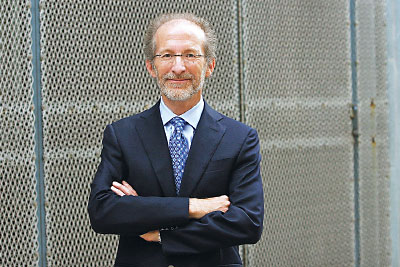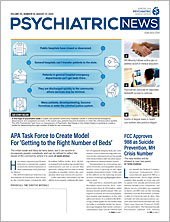Nearly 80% of North American psychiatrists responding to an online survey by APA indicated that they were experiencing burnout, according to a report posted July 14 in AJP in Advance.
In addition, 16% of respondents had a score of 10 or higher on the PHQ-9, indicating depression, and nearly all of them—98%—also indicated they were experiencing burnout.
“The key takeaway here is that if you see someone who you think might be experiencing burnout, you must also screen them for depression,” said Tristan Gorrindo, M.D., APA director of education and a co-author of the AJP report. “This study suggests a lot of overlap in the symptoms, but we know the treatments are very different.”
The survey was conducted from October 30, 2017, through December 10, 2018. But lead author Richard Summers, M.D., former chair of the APA Workgroup on Psychiatrist Well-Being and Burnout, said the impact of burnout and depression among psychiatrists is likely only to be exacerbated by the global COVID-19 pandemic.
“It’s a new world since the pandemic,” Summers said. “Psychiatrists already struggling with significant burnout and depression are further stressed by increasing clinical care demands, the anxiety of potential exposure to the virus in the clinic or hospital, and the losses imposed by the pandemic on their personal lives and their families.”
Psychiatrists, including APA members and nonmembers, were invited to participate in the survey through direct email, electronic announcements, newsletters, and solicitations at a variety of town halls and conferences.
Respondents completed the Oldenburg Burnout Inventory (OLBI), a 16-item scale designed to measure burnout across a wide variety of occupations; a score of 35 (out of 64) or above indicates increased risk for burnout. They also completed the Patient Health Questionnaire-9 (PHQ-9), a nine-item self-report scale; a cutoff score of 10 or higher indicates moderate or severe depression.
Data from 2,084 psychiatrists were included in the final analysis. No identifying information was collected.
The average OLBI score of the sample was 40.4, and 78% of respondents had scores that were above the cutoff score of 35, indicating a high likelihood of burnout. The average PHQ-9 score was 5.1; 16% of respondents had a PHQ-9 score of 10 or higher, consistent with moderate or severe depression.
After adjusting for confounding variables, the following demographic and practice-related variables were found to be significantly associated with burnout: mild, moderate, or severe depression; female gender; and self-report of having no control over one’s professional schedule.
The authors said that the high degree of overlap between burnout and depression calls for the clinical expertise of psychiatrists to distinguish between the two phenomena. They noted that burnout is “regarded as an experience rather than as a diagnostic entity, and it is better understood dimensionally rather than categorically.” In contrast, depression reflects specific psychiatric diagnostic characteristics.
(Other authors on the report included Rashi Aggarwal, M.D., and Constance Guille, M.D., members of the APA Workgroup on Psychiatrist Well-Being and Burnout; and Seungyoung Hwang, M.S., M.S.E, a statistician in the APA Division of Research. The authors thanked their colleagues on the workgroup.)
In an editorial accompanying the report, Summers wrote, “Burnout is a problem that requires solutions on multiple levels: the economic system (employer-employee balance of control, investment in human capital or technology), the health care system (the physician’s role, technology, licensure and credentialing policies), health care organizations (physician productivity, electronic medical records, organization of services, relationship and management structure), departments and clinics (leadership, administrative structure, relationships, workflow, support), and individuals (healthy work-life balance, resilience enhancement, access to mental health services).”
The authors offered five recommendations for further research and refinement of the survey results:
•
Continuing research on burnout among subgroups including women, minorities underrepresented in medicine, and psychiatrists working part time or in other alternative schedule or practice arrangements.
•
Identifying individual and workplace factors that could predict burnout, depression, and suicide risk among psychiatrists so that preventive interventions can be developed.
•
Gathering data on individual qualitative factors that would allow for a more nuanced analysis of some of the phenomena associated with burnout and depression.
•
Increasing attention on health care system–level interventions, as burnout is fundamentally an organizational problem that affects individuals.
•
Developing a longitudinal study of physicians and psychiatrists as they progress through training and practice to clarify the temporal relationship and overlap between burnout and depression, as well as the impact of interventions on each.
In comments to Psychiatric News in mid-July, Summers suggested that failures of leadership in response to the global pandemic at the highest levels of government have exacerbated the crisis of burnout.
“Caring for patients who may be COVID positive is critically necessary, but some doctors experience a fraying of the social contract between physicians and society,” he said. “They feel this way because they view the leadership provided by government and public health entities during the pandemic as flawed and dangerous.”
He added, “The quadruple aim of health care adds to the traditional three aims—improving population health, enhancing the experience of care, and reducing per capita cost—a fourth aim, attaining joy in work. In the world of COVID, we need this more than ever to direct attention and resources to physician well-being.”
Gorrindo said APA continues to focus on burnout as one of the biggest workforce challenges of the day. “The number of psychiatrists coming into the field each year from residency roughly matches the number of psychiatrists who retire each year,” he told Psychiatric News. “As a specialty we can’t afford to have more psychiatrists cut back on clinical work because of burnout.” ■
“Well-Being, Burnout, and Depression Among North American Psychiatrists: The State of Our Profession” is posted
here.
“The Elephant in the Room: What Burnout Is and What It Is Not” is posted
here.

